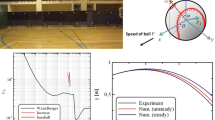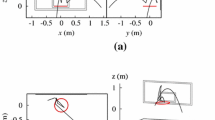Abstract
The Magnus effect is responsible for deflecting the trajectory of a spinning baseball. The deflection at the end of the trajectory can be estimated by simulating some similar trajectories or by clustering real paths; however, previous to this study, there are no reports for a detailed connection between the initial throw conditions and the resulting deflection by using. The only approximation about this is the PITCHf/x algorithm, which uses the kinematics equations. In this work, deflections from simulated spinning throws with random linear and angular velocities and spin axis parallel to the horizontal plane are analyzed in their polar representation. A cardioid function is proposed to express the vertical deflection as response of the angular velocity. This is based on both theoretical arguments from the ball movement equations and from the numerical solution of such equations. We found that the vertical deflection fits a cardioid model as function of the Magnus coefficient and the spin angle, for a set of trajectories with initial linear velocities symmetrically distributed around the direction of motion. A variation of the model can be applied to estimate the radial deflection whereas an extended model should be explored for trajectories with velocities asymmetrically distributed. The model is suitable for many applications: from video games to pitching machines. In addition, the model approaches to the results obatined with the kinematic equations, which serves as validation of the PITCHf/x algorithm.
Similar content being viewed by others
References
Adair, R.K.: The Physics of Baseball. Harper Collins, New York (2002)
Robinson, G., Robinson, I.: The motion of an arbitrarily rotating spherical projectile and its application to ball games. Phys. Scr. 88, 018101 (2014)
Cross, R.: Physics of Baseball & Softball. Springer, Berlin (2011)
Briggs, L.J.: Effect of spin and speed on the lateral deflection (curve) of a baseball; and the Magnus effect for smooth spheres. Am. J. Phys. 27, 589–596 (1959)
Nathan, A.M.: The effect of spin on the flight of a baseball. Am. J. Phys. 76, 119–124 (2008)
Nathan, A.M., Hopkins, J., Chong, L., Kaczmarski, H.: The effect of spin on the flight of a baseball. In: Moritz, E.F., Haake, S. (eds.) The Engineering of Sport 6, pp 23–28. Springer, Berlin (2006)
Kray, T., Franke, J., Frank, W.: Magnus effect on a rotating soccer ball at high Reynolds numbers. J. Wind Eng. Ind. Aerodyn. 124, 46–53 (2014)
Alaways, L.W.: Aerodynamics of the curve-ball: an investigation of the effects of angular velocity on baseball trajectories, PhD Thesis, University of California (1998)
Adair, R.K.: The physics of baseball. Phys. Today 48, 26–31 (1995). https://doi.org/10.1063/1.881460
Aguirre-López, M.A., Morales-Castillo, J., Díaz-Hernández, O., Escalera Santos, G.J., Almaguer, F-J.: Trajectories reconstruction of spinning baseball pitches by three-point-based algorithm. Appl. Math. Comput. 319, 2–12 (2018)
Clark, J.M., Greer, M.L., Semon, M.D.: Modeling pitch trajectories in fastpitch softball. Sports Eng. 18, 157–164 (2015)
Kistemaker, D.A., Faber, H., Beek, P.J.: Catching fly balls: a simulation study of the Chapman strategy. Hum. Mov. Sci. 28, 236–249 (2009)
Nathan, A.M.: Analysis of PITCHf/x pitched baseball trajectories. Document available on: https://www.researchgate.net/publication/228563555_Analysis_of_PITCHfx_Pitched_Baseball_Trajectories (accessed 03 August 2018) (2008)
Pane, M.A.: Trouble with the curve: identifying clusters of MLB pitchers using improved pitch classification techniques. PhD Thesis, Carnegie Mellon University (2013)
Nagami, T., Higuchi, T., Kanosue, K.: How baseball spin influences the performance of a pitcher. J. Phys. Fitness Sports Med. 2, 63–68 (2013)
Nagami, T., Higuchi, T., Nakata, H., Yanai, T., Kanosue, K.: Relation between lift force and ball spin for different baseball pitches. J. Appl. Biomech. 32, 196–204 (2016)
Nagami, T., Kimura, Y., Kanosue, K., Yanai, T.: Kinematic characteristics of various types of baseball pitches. Jpn. J. Phys. Educ. Health Sport Sci. 61, 589–605 (2016)
Crujeiras, R.M.: An introduction to statistical methods for circular data. Bol. Estad. Investig. Oper. 33, 85–107 (2017)
Alam, F., Ho, H., Smith, L., Subic, A., Chowdhury, H., Kumar, A.: A study of baseball and softball aerodynamics. Procedia Eng. 34, 86–91 (2012)
Cross, R., Lindsey, C.: Measurements of drag and lift on smooth balls in flight. Eur. J. Phys. 38, 044002 (2017)
Kensrud, J.R., Smith, L.V.: In situ drag measurements of sports balls. Procedia Eng. 2, 2437–2442 (2010)
Sayers, A.T., Hill, A.: Aerodynamics of a cricket ball. J. Wind Eng. Ind. Aerodyn. 79, 169–182 (1999)
Goodwill, S.R., Chin, S.B., Haake, S.J.: Aerodynamics of spinning and non-spinning tennis balls. J. Wind Eng. Ind. Aerodyn. 92, 935–958 (2004)
Core Team, R: R: a Language and Environment for Statistical Computing. R Foundation for Statistical Computing, Vienna. https://www.R-project.org/ (2018)
Nathan, A. The physics of a baseball. http://baseball.physics.illinois.edu/pitchtracker.html
Kagan, D., Nathan, A.: Simplified models for the drag coefficient of a pitched baseball. Phys. Teach. https://doi.org/10.1119/1.4872406
Acknowledgements
Authors thank Pablo Padilla-Longoria and Rosa Isela Hernández-Zamora for their feedback and suggestions for this investigation. FHZ expresses his gratitude for the support from Consejo Nacional de Ciencia y Tecnología (CONACyT-México), Cátedra 873.
Author information
Authors and Affiliations
Corresponding author
Additional information
Communicated by: Pavel Solin
Publisher’s note
Springer Nature remains neutral with regard to jurisdictional claims in published maps and institutional affiliations.
Rights and permissions
About this article
Cite this article
Aguirre-López, M.A., Díaz-Hernández, O., Hueyotl-Zahuantitla, F. et al. A cardioid-parametric model for the Magnus effect in baseballs. Adv Comput Math 45, 2097–2109 (2019). https://doi.org/10.1007/s10444-019-09694-w
Received:
Accepted:
Published:
Issue Date:
DOI: https://doi.org/10.1007/s10444-019-09694-w




